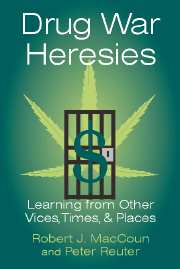Book contents
- Frontmatter
- Contents
- List of Figures and Tables
- Acknowledgments
- PART I OVERVIEW
- PART II THE ARGUMENTS
- PART III THE EVIDENCE
- 7 Other Vices: Prostitution and Gambling
- 8 Other Substances: Alcohol and Cigarettes
- 9 U.S. Experience with Legal Cocaine and Heroin
- 10 Learning from European Experiences
- 11 Cannabis Policies in The Netherlands
- 12 Harm Reduction in Europe
- PART IV ASSESSING THE ALTERNATIVES
- Bibliography
- Data Sources for Figures
- Author Index
- Subject Index
9 - U.S. Experience with Legal Cocaine and Heroin
Published online by Cambridge University Press: 24 May 2010
- Frontmatter
- Contents
- List of Figures and Tables
- Acknowledgments
- PART I OVERVIEW
- PART II THE ARGUMENTS
- PART III THE EVIDENCE
- 7 Other Vices: Prostitution and Gambling
- 8 Other Substances: Alcohol and Cigarettes
- 9 U.S. Experience with Legal Cocaine and Heroin
- 10 Learning from European Experiences
- 11 Cannabis Policies in The Netherlands
- 12 Harm Reduction in Europe
- PART IV ASSESSING THE ALTERNATIVES
- Bibliography
- Data Sources for Figures
- Author Index
- Subject Index
Summary
The United States is not without experience of legally available cocaine and heroin. From the early 1880s until about 1905, there were no criminal prohibitions against either the sale or use of these drugs, as indeed there were no regulations governing the use and distribution of any psychoactive substances, except for alcohol. By 1905, various state laws were passed prohibiting the sale or distribution of opiates and cocaine and in 1915 the Harrison Act closed down legal retailing nationwide. Ironically, between about 1890 and 1920, it was possible in many states to purchase heroin or cocaine legally, though the sale of alcoholic beverages and cigarettes was prohibited.
History does not repeat itself; at best it crudely paraphrases. Late twentieth-century America – affluent, suburban, postindustrial, with its emphasis on individual rights and self-expression – is so different from the nation of a century ago that only the most naïve would expect legal opiates and cocaine to produce the same patterns of use, abuse, and related problems. Yet the experiences of that time are a frequent reference in the contemporary legalization debate, usually in the form of “we tried legal availability and it failed,” the antithesis of the more ubiquitous “we tried Prohibition and it failed.” Even the proponents of legalization seem uneasy about the historical experience with legal cocaine and opiates, though they emphasize the slight relationship between drug use and crime prior to prohibition (e.g., Miller, 1991).
- Type
- Chapter
- Information
- Drug War HeresiesLearning from Other Vices, Times, and Places, pp. 183 - 204Publisher: Cambridge University PressPrint publication year: 2001

